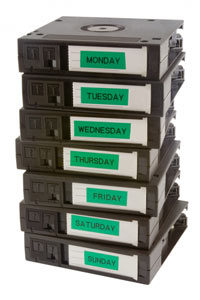Tape is a still being used today as a back-up method for some businesses. Tapes often contain business-critical data that cannot be easily recreated. When a tape fails, it can be a very intricate process to recover the vital contents stored on them. There are many factors that can cause data on these devices to be inaccessible by normal reading devices.
Tape Data Recovery & Conversion Services
Some of the most common causes of tape failure are:
- Heat and Smoke Damage
- Water Damage – Sprinkler System or Flooded
- Damage Resulting from Dropping the Cartridge
- Data Residing after an EOF Mark (Overwritten)
- Damage Resulting from the Tape Drive
- Damage as a Result of Aging (Past Warranty)
- Damage Resulting from Exposure to Extreme Temperatures or Humidity
- Internal Cartridge Mechanism Failing
- Permanent Errors Residing Mid File
Examples of Damaged Tapes that have been successfully recovered:
- Water Damaged Tape
- Missing Oxide
- Z-Fold
- Sliced Edges
- Stiction Caused Missing Oxide
- No Oxide
- Blade Damage
- Bad Oxide
- Stiction Damage
- Severe Stiction Damage
- Stiction Deposits
- Additional Stiction Deposits

As in all data recovery operations, recovering data from tapes is very specialized. There are primarily two recovery types – physical and logical.
Physical Data Recovery is necessary when there is a physical problem with the media or plastics which prevents the data from being read normally. This type of data recovery may include dealing with issues such as deteriorating magnetic coatings, cracked or broken reels/cartridge shells, creased tape edges, twisted or folded tape, stretched or broken tape, etc. This data recovery also includes capturing the data from media that has been subjected to adverse conditions such as water, mud, or other debris.
Logical Data Recovery includes recovering the data portion of a tape that was successfully recorded, but for some unknown reason cannot be read. The recovery of files from this type of problem often requires multiple passes using proprietary software that restores the file to a new storage device. Logical recovery also includes tapes that were written with misaligned heads or were re-initialized by mistake.
Tape Data Conversion Services
Data Conversion is defined as the changing of the data structure to accommodate new needs for the data. An example of this is converting from EBCDIC to ASCII. Simple data conversions can be defined as transferring files between different operating systems or backup routines without converting the data. An example of this would be transferring data between different PC backups such as Sytos Plus to NT Backup. More complex data conversions involve converting the file structure and writing the converted data to a different tape and/or operating system. An example would be the conversion of DC600 System 36 files into text files on a CD.
Tape Format Conversion Services
Format conversion is the transfer of data between logical formats to enable the reading of data on one platform having been written to another. Examples would include: reading a tape on an NT platform having been written as a UNIX TAR file.
Tape Format Conversion Services
Format conversion is the transfer of data between logical formats to enable the reading of data on one platform having been written to another. Examples would include: reading a tape on an NT platform having been written as a UNIX TAR file.
Tape Media Conversion Services
Media conversion is handling different magnetic or opto-magnetic media. Examples of media conversions are: Duplicating sets of master tapes to create backup copies, duplicating a DDS-4 tape onto DDS1 tape.
Examples of Media Types:
- 3420
- 3480Me
- 3570 B & C
- 4mm DDS-1 – DDS-5
- 8mm
- DLT 3 & 4
- SDLT 1 & 2
- LTO 1,2,3
- CDR

Find a Data Recovery Lab location near you.
DataTech Labs® knows how valuable your data is. We also understand how vital it is that your data is recovered as quickly as possible after a experiencing a failure or crash. That is why DataTech Labs has Authorized Data Recovery Service Centers nationwide. We have listed all the recovery labs for your convenience. Click the map to find a location near you.
Ready to get your data back?
Submit a case now to and tell us everything we need to know to get your data recovery going. Just fill out the form and we will get to work immediately on recovering your valuable data.
Call Now.
Call now to speak to a representative who will do an instant evaluation and give you an immediate quote. No purchase necessary.


